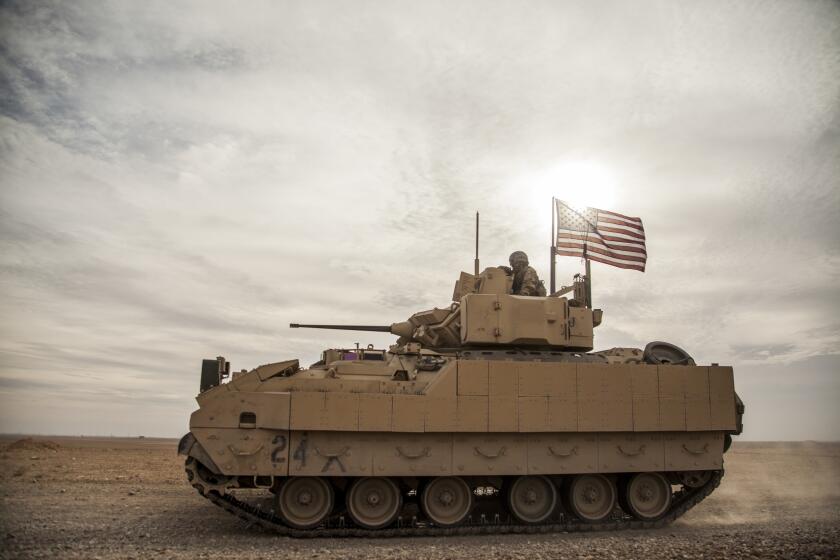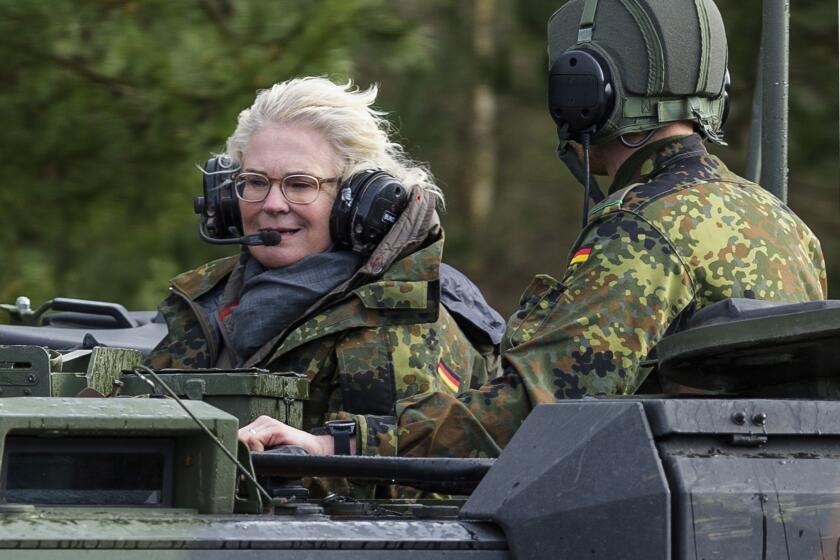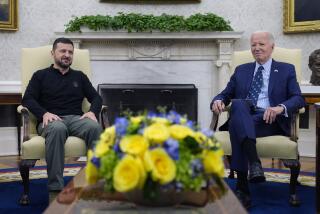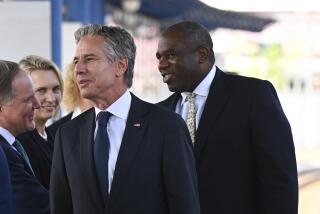Pressure grows on Germany to send tanks to Ukraine as Kyiv airs its frustration
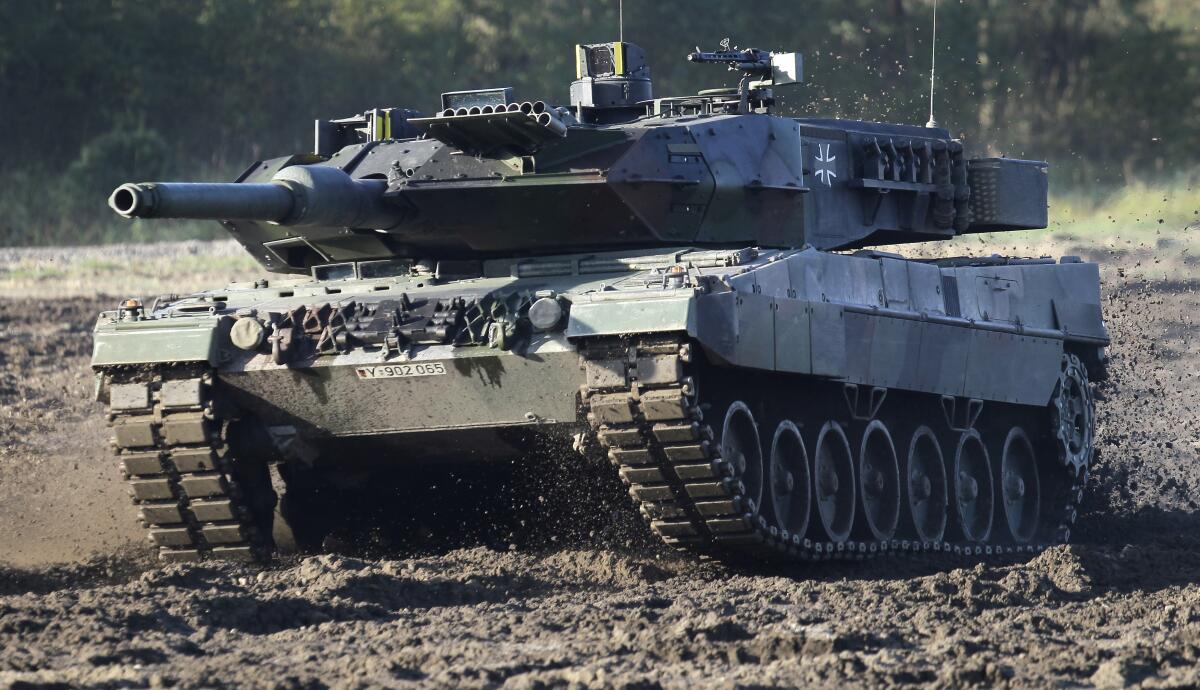
- Share via
BERLIN — Germany faced mounting pressure to supply battle tanks to Kyiv and Ukrainian President Volodymyr Zelensky aired frustration about not obtaining enough weaponry as Western allies conferred Thursday on how best to support Ukraine nearly 11 months after Russia’s invasion.
Since the U.K. announced last week that it will send Challenger 2 tanks, Berlin has faced increasing calls to supply Leopard 2 tanks or at least clear the way for others, such as Poland, to deliver German-made Leopards from their own stock.
Germany’s new defense minister, Boris Pistorius, left open whether that will happen and under what conditions after meeting on his first day in office with U.S. Defense Secretary Lloyd J. Austin III.
Pistorius told ARD television he was “pretty sure we will get a decision on this in the coming days, but I can’t yet tell you today how it will look.”
Austin will host a regular coordination meeting of top defense officials from Ukraine’s Western allies at the United States’ Ramstein Air Base in Germany on Friday.
Speaking by video link on the sidelines of the World Economic Forum’s annual meeting in Davos, Switzerland, Zelensky offered a veiled critique of major supporters such as Germany and the U.S. that have hesitated over sending tanks.
He bemoaned a “lack of specific weaponry.”
Armored vehicles from the U.S. and Germany, including 50 tank-killing Bradleys, should expand Ukraine’s ability to move troops to the front lines.
Speaking through an interpreter, Zelensky said: “There are times where we shouldn’t hesitate or we shouldn’t compare when someone says, ‘I will give tanks if someone else will also share his tanks.’”
Ukraine’s foreign and defense ministers said that the Challenger 2 tanks Britain plans to supply, while welcome, are “not sufficient to achieve operational goals.”
“We guarantee that we will use these weapons responsibly and exclusively for the purposes of protecting the territorial integrity of Ukraine within internationally recognized borders,” Dmytro Kuleba and Oleksii Reznikov said, appealing to Germany and other countries that use the German-made Leopard 2 to join an “international tank coalition.”
For months, Ukraine has sought heavier vehicles such as the Leopard and U.S. Abrams tanks, but Western leaders have been treading carefully.
Defense Minister Christine Lambrecht’s resignation follows persistent criticism of Germany’s military modernization and arms shipments to Ukraine.
Germany has been particularly in focus in recent days. Critics, some inside Germany’s governing coalition, have long complained of Chancellor Olaf Scholz’s perceived hesitancy to take the next step when it comes to weapons deliveries.
Scholz has been wary of such pressure, insisting that Germany won’t go it alone and pointing to a need to ensure that the North Atlantic Treaty Organization doesn’t become a party to the war against Russia; every time, however, Berlin has eventually taken a step forward. Scholz has portrayed his cautious weighing of each step as a virtue.
In Davos on Wednesday, the chancellor avoided directly answering a question about Leopard tanks, saying that Germany would remain one of Ukraine’s top weapons suppliers and that “we are never doing something just by ourselves, but together with others — especially the United States.”
German officials have conveyed their reluctance to allow allies to give their German-made Leopards to Ukraine unless the U.S. also sends Abrams tanks, according to a U.S. official who was not authorized to comment and spoke on condition of anonymity.
Asked whether Germany would deliver Leopards only if Washington supplies the Abrams, Pistorius replied that he wasn’t “aware of such a package.” But he said that aid must continue to be “coordinated” and that it’s important for Germany to proceed “shoulder to shoulder with the Americans.”
An upcoming package of U.S. military aid is expected to include nearly 100 Stryker combat vehicles and at least 50 Bradley armored vehicles — but not the Abrams, which U.S. officials say has complex maintenance needs and may not be the best fit.
“The maintenance and the high cost that it would take to maintain an Abrams — it just doesn’t make sense to provide that to the Ukrainians at this moment,” spokeswoman Sabrina Singh said at a Pentagon briefing Thursday.
Tuesday’s meeting between the top U.S. and Ukrainian military chiefs underscores the growing ties between the two sides amid Russia’s war on Ukraine.
Some eastern NATO allies have provided Soviet-era T-72 tanks to Ukrainian forces, but officials acknowledge that supplies of Soviet-era equipment with which Ukrainian forces are already familiar are limited.
Senior officials from Britain, Poland, the Baltic nations and other European countries met in Estonia on Thursday before the Ramstein gathering.
U.K. Defense Secretary Ben Wallace said his country would send at least three batteries of AS-90 artillery, armored vehicles, thousands of rounds of ammunition and 600 Brimstone missiles, as well as the squadron of Challenger 2 tanks.
Wallace told the Associated Press that the decision to send battle tanks was a “natural progression” of U.K. military support for Ukraine and was discussed with the U.S.
The Pentagon says about 100 Ukrainians will head to Oklahoma’s Ft. Sill in coming days to begin training on how to use Patriot missile system.
“If you’re going to donate armored personnel carriers, you need to complement that with tanks,” he said. “We had some tanks that we thought could do that.”
Wallace acknowledged that the Challenger shipment “is not the single magic ingredient” for Ukraine, which has said it needs 300 tanks, among other weapons, to expel Russian forces. But he voiced hope that it will complement Bradley armored vehicles the U.S. is already supplying and help “lead the way” for others to send tanks.
Estonia announced its largest military aid package to date, including howitzers, ammunition, artillery support equipment and grenade launchers.
For the record:
4:59 a.m. Jan. 19, 2023A previous version of this story mistakenly said that Sweden is providing an antitank robot to Ukraine. It is providing a shoulder-fired antitank missile system.
Elsewhere, Swedish Prime Minister Ulf Kristersson said his country has decided to send up to 50 Swedish-made combat vehicles, a shoulder-fired antitank missile system and the Archer artillery system to Ukraine.
And Denmark plans to donate 19 French-made Caesar self-propelled howitzers.
More to Read
Sign up for Essential California
The most important California stories and recommendations in your inbox every morning.
You may occasionally receive promotional content from the Los Angeles Times.
